What is crypto mining? Let’s learn the basics of bitcoin mining. Bitcoins can be transferred around the clock via a Bitcoin network. These transactions are collected in a ‘block’ and processed approximately every 10 minutes.
It’s the job of a Bitcoin miner to find or ‘mine’ this block. To do this, he/she has to provide computing power and solve a cryptographic (mathematical) puzzle. A miner who first solves the puzzle for the current block receives a reward in the form of bitcoins (BTC). Currently, the reward is 6.25 BTC. The block found by mining is added to the existing blockchain.
If you still wonder ‘What is crypto mining?’, then make sure you read this article till the end. Let’s get started!
What is a Crypto Mining Pool: Definition & Key Features
What is a crypto mining pool? Let’s try to find out! With a mining pool, the computing power of each participant is united centrally. The reward for finding a Bitcoin block is divided proportionally among all pool participants. The main advantage compared to mining yourself is that you receive regular payouts from a mining pool.
Once we’ve received an answer on ‘What is a crypto mining pool?’ question, let’s find out how profitable a crypto mining is. The ratio of the following parameters is essential for calculating how profitable Bitcoin mining is:
-
- Hashing computing power in hash/second;
-
- Bitcoin difficulty level;
-
- Energy consumption in watts;
-
- Energy costs in kilowatts/hour;
-
- If it’s a mining pool, the number of fees.
The return on mining cannot, therefore, be generalized. It largely depends on the parameters mentioned. It would be dubious to reliably name a profitability indicator in this case.
Not only bitcoins can be mined. Other cryptocurrencies such as Monero, Ethereum, Litecoin, Verge, Peercoin etc. are also available.
What is Crypto Cloud Mining: What is Online Crypto Mining Definition
What is online crypto mining? Cloud mining describes a special type of Bitcoin mining in which you don’t need to have any mining hardware, but rent or buy it from a data center.
Mining takes place remotely in a cloud. For mining investors, it’s a stress-free alternative to own mining or a mining pool because they don’t have to worry about electricity costs, hardware, software, or bandwidth.
What is a Deadline for Crypto Mining: What Will Happen in the Future?
Once we’ve found out what is crypto currency mining, let’s consider other interesting facts about mining. Bitcoins are created so that enough units are available. That is, Bitcoin can be used worldwide for as many users and applications as possible.
Mining ensures that numerous transactions can be processed. These are transferred via newly created blocks. In addition to mining earnings for finding bitcoins (6.25 BTC/block), a miner also receives transaction fees for all transactions conducted in a block.
Bitcoin earnings for miners from block rewards (6.25 BTC) are currently higher than those from transaction fees. Bitcoin halving will gradually change this.
What is mining crypto deadline? Every 4 years, the reward for finding a Bitcoin block is halved. The next halving event will take place in 2024, when the reward per block will be 3.125 BTC instead of 6.25 BTC.
The reward drops to 0 by 2140. Now one could assume that in the end, mining no longer makes sense. This isn’t the case as transaction fees will increase over time, thereby compensating for the loss of block rewards.
What other interesting facts about crypto mining do you know? Just share your knowledge in the comments!

Leave a Reply